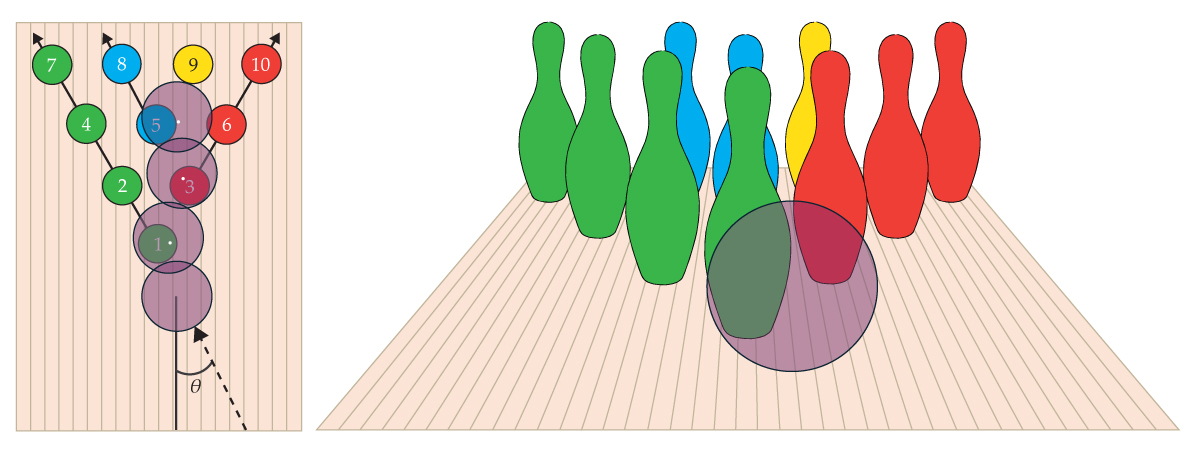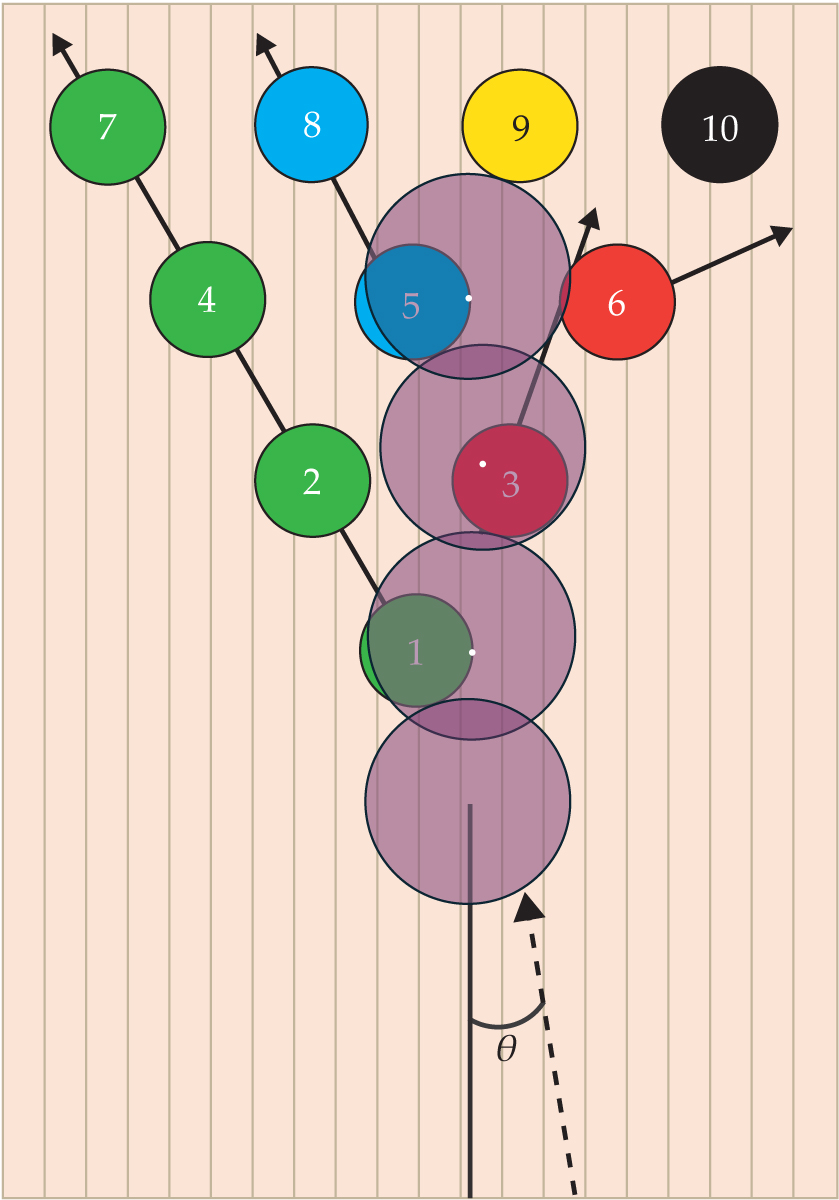The perfect strike in tenpin bowling
DOI: 10.1063/pt.bvxu.amgq
The main objective of tenpin bowling is to roll a ball down a long, narrow lane in such a way that all 10 pins at the end of the lane are knocked down. If that is achieved in one shot, it’s called a strike. Rolling strikes is the best way to accumulate big scores and win. The combination of the curved shape of the pins and potential small changes in their initial positions because of variance in the pinsetter machines means that the exact direction they travel after a collision is difficult to predict and control.
There are many ways that the pins can interact to produce a strike. In some cases, pins momentarily leave the deck where they are initially positioned, bounce off the side walls, and return to knock down pins that were briefly left standing. Though those lucky strikes might elicit a wild reaction from the crowd, they rely on a fair amount of good fortune. But amid the chaos and variety of pin action, there is a particular sequence that consistently results in a strike and relies on very little luck: what’s known as the perfect strike.
If you’ve seen videos of professionals bowling strikes, you may have noticed that the bowlers’ strategy is not to throw the ball as fast as possible. Instead, they apply rotation to the ball. By taking advantage of rotation and an oil pattern applied to the lane, experienced bowlers can unlock the ideal sequence of collisions. Here’s how it works.
Chain reaction
To achieve the perfect strike, the bowler must hit the front pin, commonly called the headpin, about 6.5 cm away from its center at a 4–6° angle. In the first part of the sequence, the headpin hits pin 2 in such a way that pin 2 hits pin 4, and then pin 4 hits pin 7. Those four pins, shown in green in figure
Next comes a crucial part of the sequence: the deflection of the ball from the headpin to pin 3. That must happen at a specific angle (more on that later) for pin 3 to hit pin 6 in the correct position and, in turn, for pin 6 to hit pin 10. After hitting pin 3, the ball carries on and hits pin 5, which sends pin 5 into pin 8, as shown by the arrow through the blue pins in the left panel of figure
Figure 1.

A perfect strike. Hitting the headpin at a specific position and angle produces a predictable sequence of collisions in which the ball hits four pins that knock down the other six. The ball first hits pin 1, which in turn hits pin 2 into pin 4, which then hits pin 7 (green). The ball then hits pin 3, which sends pin 6 into pin 10 (red). Next, the ball hits pin 5 into pin 8 (blue), before the ball finally hits pin 9 (yellow).

The sequence for a hit on the right side (from the bowler’s perspective) of the headpin, as shown in figure
Spin it
Hitting the headpin around 6.5 cm away from its center requires a great deal of accuracy. The headpin is more than 18 m from the foul line, the boundary that the players’ feet must stay behind when they release the ball. It is in a bowler’s best interest to increase the area of the headpin that can be hit such that the perfect strike results. That can be achieved through a strategy that involves imparting spin to the ball and uses the oil pattern applied to the lane to one’s advantage.
Oil is typically applied to the two-thirds of the lane closest to the bowler. There are a variety of oil patterns, but often, more oil is applied to the center of the lane than to the edges, near the gutters. The low-friction center of the lane promotes skidding, and the edges of the lane provide more traction so that the ball’s spin will start to alter its trajectory.
Figure 2.

One pin left standing. When a ball hits the headpin in the correct position but with too shallow an entry angle, pin 3 hits pin 6 out to the side instead of toward pin 10. As a result, one pin is left standing in the back corner.

If a bowler can get a ball with rotation close enough to an ideal path, the oil pattern helps funnel it to the desired position on the headpin. A spin-imparted ball that is aimed slightly too close to the gutter curves toward the center of the lane, back toward the ideal position. A ball sent slightly too close to the middle of the lane skids for longer, which lands it closer to the ideal position than it would have been if it had curved earlier in the roll. A graphical explanation can be found in my 2023 article listed in the additional resources.
Hitting the right position on the headpin will not necessarily guarantee a strike. Again, the rotation applied to the bowling ball comes into play. The entry angle θ is that between the line parallel to the edges of the lane and the path that the ball is traveling along as it hits the headpin. If the angle is too shallow, around 2–3°, as shown in figure
As the entry angle is increased up to 6°, the area of the headpin that can be hit to produce the correct deflection increases. As discussed in a 2018 technology study by the US Bowling Congress, a 6° entry angle yields a greater than 95% chance of a strike if the headpin is hit between roughly 5.0 and 7.6 cm from its center. For a 2° entry angle, however, the size of the zone that yields a strike is cut in half—there’s a 95% chance of a strike only when the headpin is hit roughly 5.7–7.0 cm from its center.
Though 6° may not seem large, angles greater than 2° can be achieved only by spinning the ball. When the ball is imparted with rotation, it skids along the oil and then gains traction at the unoiled end of the lane. There, it transitions from a skid into a pure roll, in which its translational velocity is equal to the radius of the ball multiplied by its angular velocity. During that transition, the rotation causes the ball to change direction and creates the desired entry angle into the headpin. If bowlers can hit the right speed, rotation, and area of the lane, they can bowl perfect strikes time and time again.
This article was originally published online on 29 August 2025.
References
► C. G. Hooper, “Mathematical modelling of the application of lane conditioner to a tenpin bowling lane,” Proc. Inst. Mech. Eng., Part P: J. Sports Eng. Technol. (2023). https://doi.org/10.1177/17543371231217021
► C. G. Hooper, “Increasing target size and strike percentage in tenpin bowling: An analysis of the 2017 Weber Cup,” Int. J. Sports Sci. Coach. 20, 767 (2025). https://doi.org/10.1177/17479541241306543
► S. S. M. Ji et al., “Using physics simulations to find targeting strategies in competitive tenpin bowling,” AIP Adv. 15, 045222 (2025). https://doi.org/10.1063/5.0247761
► US Bowling Congress, Bowling Technology Study: An Examination and Discussion on Technology’s Impact in the Sport of Bowling (2018). https://images.bowl.com/bowl/media/legacy/internap/bowl/equipandspecs/pdfs/TechnologyStudy/FullStudy.pdf
More about the Authors
Curtis Hooper is a doctoral fellow at the Sports Technology Institute in the Wolfson School of Mechanical, Electrical and Manufacturing Engineering at Loughborough University in the UK. An avid bowler since he was seven years old, Hooper has represented England in bowling competitions around the world, and he is a current Team England coach.

